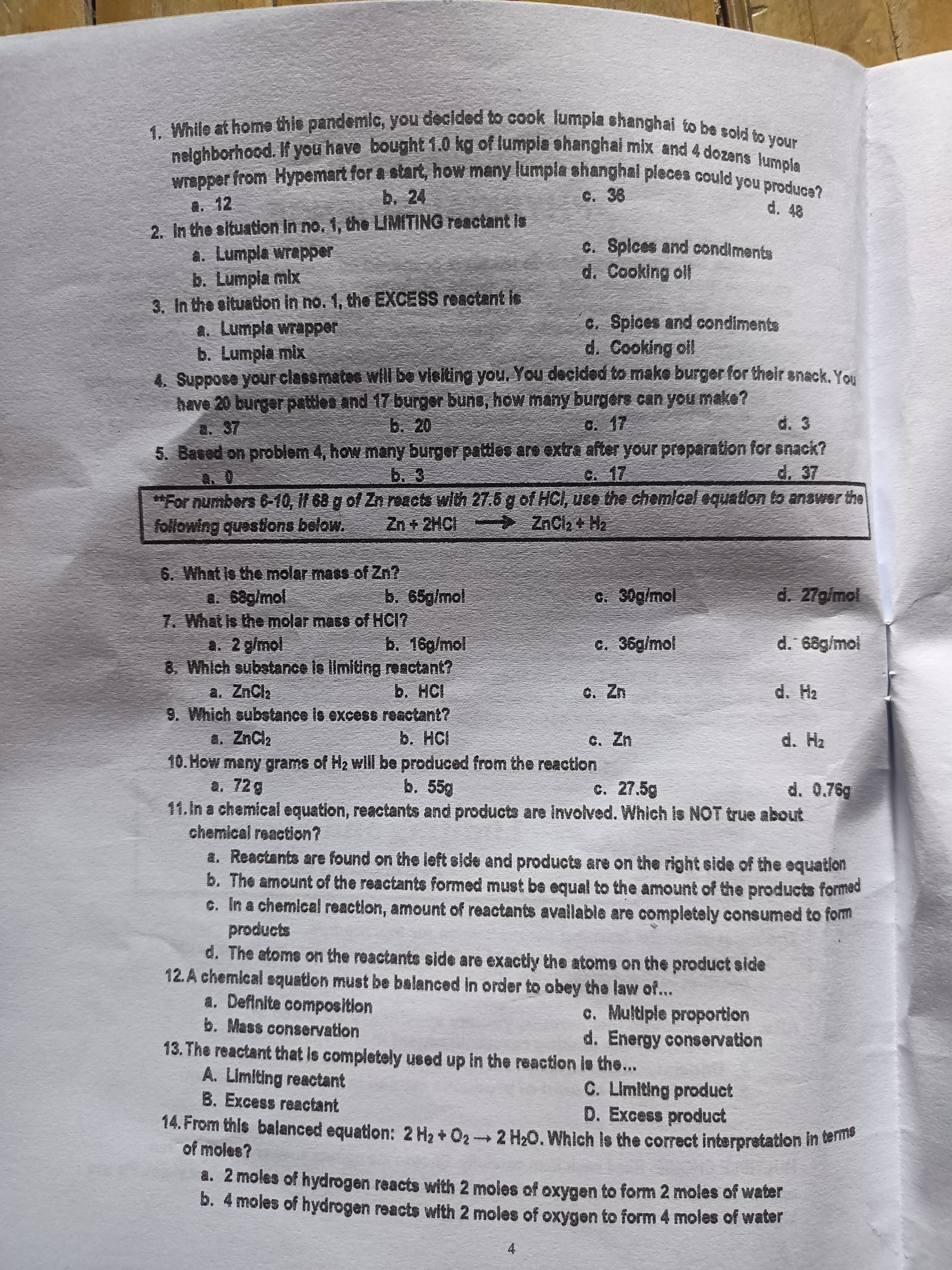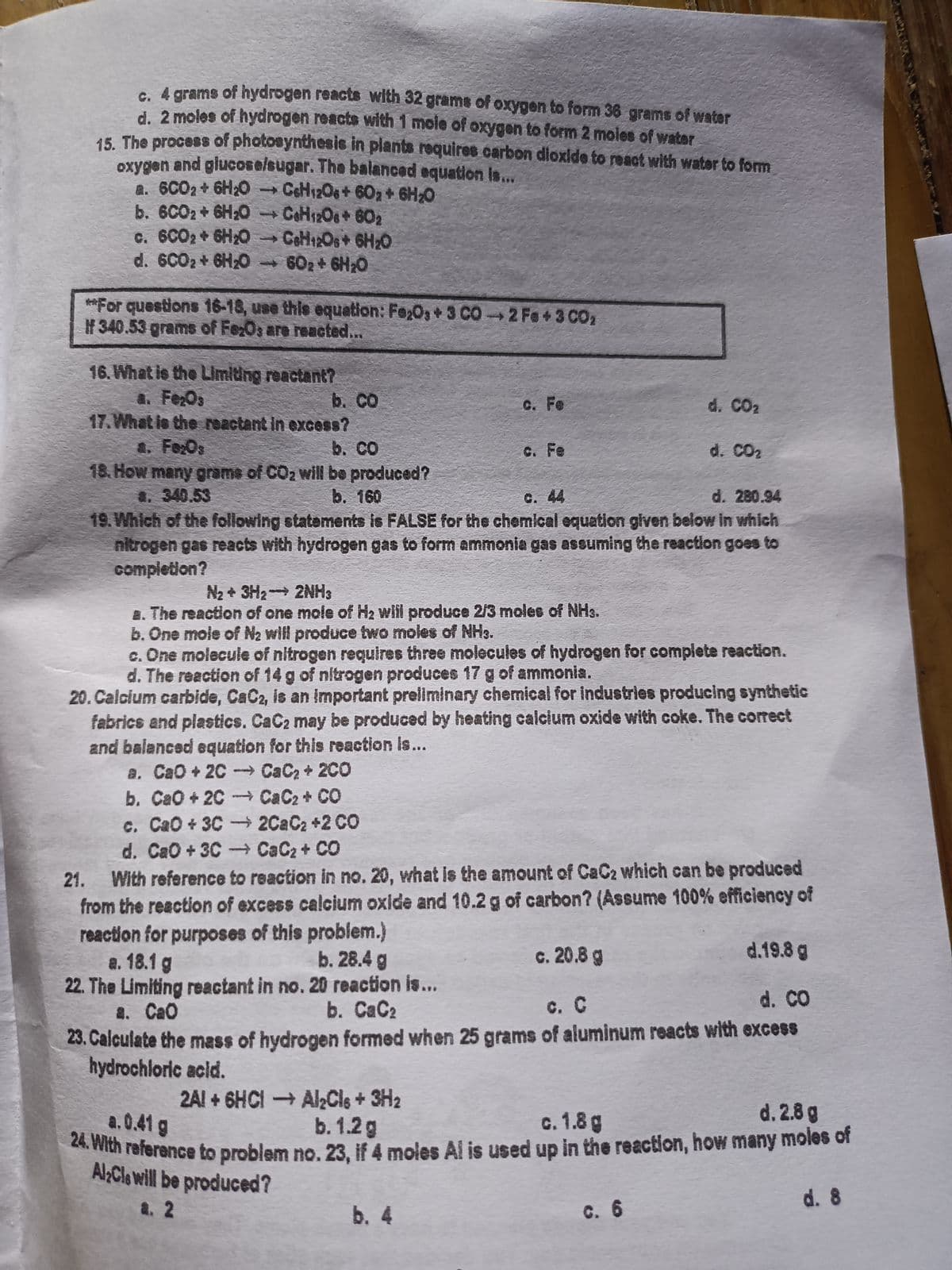13. The reactant that is completely used up in the reaction le the... A. Limiting reactant B. Excess reactant C. Limiting product D. Excess product 14. From thie balangad
13. The reactant that is completely used up in the reaction le the... A. Limiting reactant B. Excess reactant C. Limiting product D. Excess product 14. From thie balangad
Chemistry: Principles and Practice
3rd Edition
ISBN:9780534420123
Author:Daniel L. Reger, Scott R. Goode, David W. Ball, Edward Mercer
Publisher:Daniel L. Reger, Scott R. Goode, David W. Ball, Edward Mercer
Chapter14: Chemical Equilibrium
Section: Chapter Questions
Problem 14.97QE: According to the Resource Conservation and Recovery Act (RCRA), waste material is classified as...
Related questions
Question
Answer the following questions (please answer multiple choice)

Transcribed Image Text:b. 24
C. 36
a. 12
2. In the situation In no. 1, the LIMITING reactant Is
a. Lumpla wrapper
b. Lumpia mix
3. In the situation in no. 1, the EXCESS reactant is
a. Lumpla wrapper
b. Lumpia mix
4. Suppose your classmates will be vieiting you. You decided to make burger for their snack. You
have 20 burger pattles and 17 burger buns, how many burgere can you make?
d. 48
C. Spices and condiments
d. Cooking oll
c. Spices and condiments
d. Cooking oll
a. 37
b. 20
C. 17
d. 3
5. Based on problem 4, how many burger patties are extra after your proparation for snack?
d. 37
b. 3
C. 17
*For numbers 6-10, I1 68 g of Zn reacts with 27.5 g of HCI, use the chemicel equation to answer the
following questions below.
Zn + 2HCI
> ZnCla + Hz
6. What is the molar mass of Zn?
a. 68g/mol
7. What is the molar mass of HCI?
A. 2 g/mol
8 Which substance is limiting reactant?
a. ZnCla
9. Which substance is excess reactant?
a. ZnCl,
10. How many grams of H2 will be produced from the reaction
a. 72g
11.In a chemical equation, reactants and products are involved. Which is NOT true about
chemical reaction?
b. 65g/mol
c. 30g/mol
d. 27g/mol
b. 16g/mol
c. 36g/mol
d. 68g/mol
b. HCI
C. Zn
d. H2
b. HCI
C. Zn
d. Hz
b. 55g
c. 27.5g
d. 0.76g
a. Reactants are found on the left side and products are on the right side of the equation
b. The amount of the reactants formed must be equal to the amount of the products formed
c. In a chemical reaction, amount of reactants avallable are completely consumed to fom
products
d. The atoms on the reactants side are exactly the atoms on the product side
12. A chemical equation must be balanced in order to obey the law of...
a. Definite composition
c. Multiple proportion
d. Energy conservation
b. Mass conservation
13. The reactant that is completely used up in the reaction is the...
A. Limiting reactant
C. Limiting product
D. Excess product
B. Excess reactant
14. From thle balanced equation: 2 H2 + 02 2 H20. Which is the correct interpretation in a
of moles?
a. 2 moles of hydrogen reacts with 2 moles of oxygen to form 2 moles of water
b. 4 moles of hydrogen reacts with 2 moles of oxygen to form 4 moles of water

Transcribed Image Text:rams of hydrogen reacts with 32 grams of oxygen to form 36 grams of water
d. 2 moles of hydrogen reacts with 1 moie of oxygen to form 2 moles of water
15 The process of photosynthesis in plants requires carbon dioxlde to react with water to fom
oxygen and glucoselsugar. The balancad equation Is..
a. 6C02+ 6H20 CeH12O+ 602 6H20
b. 6CO2 + 6H20 COH12O8+602
c. 6CO2 6H;0 CeH12Os+ 6H20
d. 6C02+ 6H20 602+ 6H20
**For questions 16-18, use this equation: Fe;O3+ 3 CO2 Fe+3 CO2
If 340.53 grams of FeOs are reacted...
16. What is the LImiting reactant?
a. FeOs
17.What ie the reactant in excess?
b. CO
C. Fe
d. CO2
4. Fo:Os
18. How many grame of CO2 will be produced?
4. 340.53
19. Which of the following statements is FALSE for the chemical equation given below in which
nitrogen gas reacts with hydrogen gas to form ammonia gas assuming the reaction goes to
completion?
b. CO
C. Fe
d. CO2
b. 160
C. 44
d. 280.94
N2 + 3H2 2NH3
8. The reaction of one mole of H2 will produce 2/3 moles of NHs.
b. One mole of N2 will produce two moles of NH3.
c. One molecule of nitrogen requires three molecules of hydrogen for complete reaction.
d. The reaction of 14 g of nitrogen produces 17 g of ammonia.
20. Calcium carbide, CaC2, is an important preiliminary chemical for Industries producing synthetic
fabrics and plastics. CaC2 may be produced by heating calcium oxide with coke. The correct
and balanced equation for this reaction Is...
a. CaO+2C- CaC2+ 2C0
b. CaO+ 2C CaC2+ CO
c. CaO+ 3C2C2C2 +2 CO
d. CaO+3C- CaC2+ CO
With reference to reaction in no. 20, what is the amount of CaC2 which can be produced
from the reaction of excess calcium oxide and 10.2g of carbon? (Assume 100% efficiency of
reaction for purposes of this problem.)
a. 18.1 g
22. The Limiting reactant in no. 20 reaction is...
2. CaO
23. Calculate the mass of hydrogen formed when 25 grams of aluminum reacts with excess
hydrochloric acid.
21.
b. 28.4 g
c. 20.8 g
d.19.8 g
d. CO
b. СаС?
C. C
2AI + 6HCI Al2Cls + 3H2
b. 1.2g
a.0.41 g
с. 1.8 g
d. 2.8 g
mith reference to problem no. 23, if 4 moles Al is used up in the reaction, how many moles of
AlCle will be produced?
a. 2
b. 4
C. 6
d. 8
Expert Solution
This question has been solved!
Explore an expertly crafted, step-by-step solution for a thorough understanding of key concepts.
This is a popular solution!
Trending now
This is a popular solution!
Step by step
Solved in 2 steps

Knowledge Booster
Learn more about
Need a deep-dive on the concept behind this application? Look no further. Learn more about this topic, chemistry and related others by exploring similar questions and additional content below.Recommended textbooks for you

Chemistry: Principles and Practice
Chemistry
ISBN:
9780534420123
Author:
Daniel L. Reger, Scott R. Goode, David W. Ball, Edward Mercer
Publisher:
Cengage Learning

World of Chemistry, 3rd edition
Chemistry
ISBN:
9781133109655
Author:
Steven S. Zumdahl, Susan L. Zumdahl, Donald J. DeCoste
Publisher:
Brooks / Cole / Cengage Learning

Introductory Chemistry: A Foundation
Chemistry
ISBN:
9781337399425
Author:
Steven S. Zumdahl, Donald J. DeCoste
Publisher:
Cengage Learning

Chemistry: Principles and Practice
Chemistry
ISBN:
9780534420123
Author:
Daniel L. Reger, Scott R. Goode, David W. Ball, Edward Mercer
Publisher:
Cengage Learning

World of Chemistry, 3rd edition
Chemistry
ISBN:
9781133109655
Author:
Steven S. Zumdahl, Susan L. Zumdahl, Donald J. DeCoste
Publisher:
Brooks / Cole / Cengage Learning

Introductory Chemistry: A Foundation
Chemistry
ISBN:
9781337399425
Author:
Steven S. Zumdahl, Donald J. DeCoste
Publisher:
Cengage Learning

Chemistry & Chemical Reactivity
Chemistry
ISBN:
9781337399074
Author:
John C. Kotz, Paul M. Treichel, John Townsend, David Treichel
Publisher:
Cengage Learning

Chemistry & Chemical Reactivity
Chemistry
ISBN:
9781133949640
Author:
John C. Kotz, Paul M. Treichel, John Townsend, David Treichel
Publisher:
Cengage Learning

Chemistry
Chemistry
ISBN:
9781305957404
Author:
Steven S. Zumdahl, Susan A. Zumdahl, Donald J. DeCoste
Publisher:
Cengage Learning